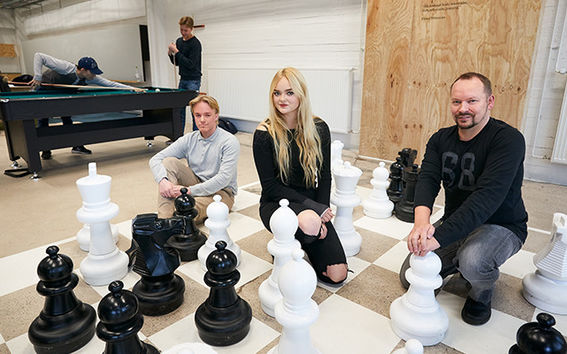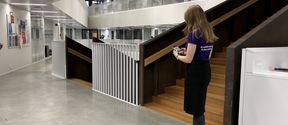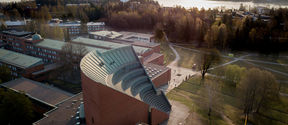Teaching throughout Otaniemi

Eemil Virkkunen, who is in his first year of upper secondary school, is pleased. He got a place on a programming course, which Aalto University is also offering to the upper secondary schools in Otaniemi, Haukilahti Upper Secondary School and Pohjois-Tapiola Upper Secondary School. The course was open to all upper secondary school students in Espoo.
'I have never done any programming before, but this course will give me good basic skills. The university’s engineering students are assistants on the course. If I pass the exams and then go on to get a place at Aalto University, I will already have completed five credits,' says Eemil.
The plan was to start the course with a group of about 20 students, but dozens of students applied.
'After the initial rush, the number of students has fallen slightly. The demands of the course are the same as those for university students, and this came as a surprise for some. Overall, the upper secondary students’ enthusiasm has also motivated the teachers,' says the course’s teacher in charge Kerttu Pollari-Malmi, senior university lecturer, Aalto University Department of Computer Science and Engineering.
Rebekka Sukselainen also sampled some academic studies during her first year of upper secondary school. 'During an Aalto University design course, we made a map of Otaniemi using a computer program. We also gave opinions on how this area could be developed,' says Rebekka.
Both Rebekka and Eemil applied for a place at Haukilahti Upper Secondary School because the students can attend university courses at Otaniemi while they are at the school. Both hope to study at one of the schools of Aalto University.
The close cooperation between the university, upper secondary schools and businesses in Otaniemi is part of the School as a Service concept. The barriers between education levels come down, the borders between subjects crumble and teachers and students work together communally.
At Pohjois-Tapiola Upper Secondary School, the teaching areas and other facilities are spacious and light.
School becomes a network
Antti Ahlava, Vice President of Aalto University, is one of the inventors of the School as a Service concept. Two years ago, he held a course with Professor Jarmo Suominen at the School of Arts, Design and Architecture, where the idea was to consider the development of the building of schools. Service designers from the Royal College of Art, London, also participated.
'It soon became clear that the goal of education and the way that schools are built are not aligned. While the new curriculum emphasises social learning and theme- and project-based activities, the building of schools is based on regulations dating back to the 19th century,' says Ahlava.
And so, the School as a Service model was created. In this model, the school is not a building or a place but a platform for collective thinking and learning. All the resources in the surrounding area are used. In Otaniemi this means that the schools making up Aalto University, the upper secondary schools and businesses work together every day. The cooperation can extend to premises and teaching and also various projects.
'The school becomes a network, and the interaction of students with other people in the community increases.'
According to Ahlava this is a new form of platform economy.'The local area offers services to schools. In Otaniemi, Aalto University has been the service operator, but other parties could also maintain and develop teaching services.'
Ahlava was surprised at how enthusiastic the City of Espoo was about piloting the model. It became a joint project of the university, Aalto University Properties Ltd and the City of Espoo. 'It was also a surprise to see how actively Aalto University lecturers at the Language Centre and the schools of Aalto University have made their courses available to upper secondary school students.'
Antti Ahlava, Vice President of Aalto University, explains that an elementary school is currently being designed based on the School as a Service model.
Comprehensive education on board next
The new operating model has already become established, as Haukilahti Upper Secondary School has been operating in Otaniemi for a year now and Pohjois-Tapiola Upper Secondary School for a few months. However, the model is developing all the time.
'We are currently designing an elementary school based on the model for Otaniemi in Espoo. It will open its doors in January 2019,' says Vice President Ahlava.
The model has attracted a lot of interest around the world and it has received the International Quality Innovation Prize.
Visitors from China play table tennis in the Valtameri space at the Haukilahti Upper Secondary School.
Visitors help to spread the idea
Chinese visitors flow through the doors of the Haukilahti Upper Secondary School’s auditorium on a November morning. They are also interested in the new way of learning, teaching and working as a community, as a Chinese application has already been created. Both upper secondary schools get visitors from Finland and all over the world every week.
The visit is a journey into the future of learning, a new way of learning and teaching.
Some of the visitors have held lectures. A while ago, Philosopher Esa Saarinen, who visited the Haukilahti Upper Secondary School, provided inspiration for collective thinking. Prime Minister Juha Sipilä also came to talk with the students at Haukilahti. A thesis defence event was held in the auditorium in November for the first time and students were able to attend.
The teachers from China find an easy connection with the students today: A group of people congregate in the students’ recreational space when a visitor starts playing table tennis with one of the students. The cheering spectators are equally as enthusiastic as the players.
Focus on student guidance
The rolling out of the new model has increased the workload of the principals and teachers. 'However, it is so rewarding that everyone has enthusiastically come on board. Each person feels like they are building something new and unique,' says Sinikka Luoma-Mattila, Principal of Pohjois-Tapiola Upper Secondary School and Pekka Piri, Principal of Haukilahti Upper Secondary School.
Erika Ripatti, teacher of history and social studies, is amazed at how quickly the cooperation within the campus started up.'Within a couple of months, we were able to launch cooperation with the Aalto Start-Up Center business accelerator that is based in the same building. Other partners are the Urban Mill space that functions as a collaboration platform and the School of Arts, Design and Architecture. The lists of partners just grow, and the projects related to entrepreneurship, for example, are increasing.'
The teachers of the two upper secondary schools cooperate closely together and with the university lecturers. This allows them to stay up-to-date with matters related to the education levels and to take these into account in their work.
Vice President of Aalto University Tuija Pulkkinen (left), Principal of Pohjois-Tapiola Upper Secondary School Sinikka Luoma-Mattila, student Tomi Kotiluoto and Director of Education at the City of Espoo Kaisu Toivonen represent different parties in the School as a Service model. The cooperation is close.
As so many things have changed regarding everyday practical matters alone, more attention than usual has been focused on student counselling. Students at Haukilahti Upper Secondary School have two student counsellors.
'It is important for us to reinforce the sense of community. Though the building is now less significant, the importance of the group and community is increasing. Students also start to think about their career much earlier than usual these days and support is needed for this. One reason that students are thinking about their future career paths even earlier is because the upper secondary school matriculation exam is now more important when universities select students,' says Antti Humalamäki, upper secondary school guidance counsellor.
Photos: Kimmo Räisänen
| New concept of space |
|---|
|
Haukilahti Upper Secondary School in Espoo has 380 students and it has been located in Otaniemi since autumn 2016. Pohjois-Tapiola Upper Secondary School, which has about 400 students, moved to the area in August 2017. One principle of the School as a Service concept is that activities, not the buildings, form the essential factors of the school. Sharing is the key factor in the idea of space: the spaces used by the students are partly shared with other parties operating in the Otaniemi campus. The upper secondary schools operate at as many as seven different addresses. For example, physical education takes place at Otaniemi sports field and Otahalli sports centre, physics classes, visual arts and chemistry laboratory classes are held at the university’s premises. The cafeteria is located at another address. During the previous academic year, Haukilahti Upper Secondary School students used Aalto University's premises for 1 200 hours in total. 'The new model allows the city to considerably cut costs, increase operational flexibility and reduce its carbon footprint,' says Eetu Ristaniemi, Director, Real Estate Investments at Aalto University Properties Ltd. According to him, there has been a considerable increase in the utilisation rate of Aalto University’s laboratories and the other premises used by upper secondary school students. The implementation of the School as a Service concept has not required the building of any new premises because old premises have been adapted, making them easier to convert. Haukilahti Upper Secondary School’s Laine building was previously used by Aalto University's Forest Products Technology, and the Open Innovation House is home to Pohjois-Tapiola Upper Secondary School. 'The main thing is that qualitative measurements show that, among other things, student satisfaction has improved. The number of applicants to Haukilahti Upper Secondary School has grown by as much as 150 per cent,' says Ristaniemi. Aalto University Properties has been responsible for the design and furnishing of the premises. |
Read more news

Stay safe near metro stations
When walking on the streets, it is crucial to stay alert to avoid being scammed.
Temporary traffic arrangements on Lämpömiehenkuja and Metallimiehenkuja
The new arrangements will be implemented starting Monday, November 24, 2025.
Accessible routes in Aalto Space application
You can also choose an accessible route for navigation on campus.






